Confederate Occupation
On August 28th, 1861, the 3rd Georgia Volunteers receive orders to leave their encampment at the Gosport Shipyard in Portsmouth, Virginia and re-enforce North Carolina troops defending Hatteras Inlet, North Carolina, 120 miles to the south. The North Carolinians, manning Forts Clark and Hatteras on the north side of the inlet, are under impending attack by a combined Federal Army - Navy Expedition.
Colonel A. R. Wright in command of the 3rd Georgia musters four of his companies who embark on to barges which are towed by the steam tugboat Kaukee. The Kaukee steams south through the Chesapeake and Albemarle canal and into North Carolina's Currituck Sound. Continuing south, the tug and barges enter and pass through Albemarle Sound, then steam through Croatan Sound on Roanoke Islands west side. The Georgians are just south of the island when they meet sailboats heading north. The boats are captained by fishermen fleeing from Hatteras with news that the Confederate garrison there surrendered to Union forces on August 29th. Colonel Wright orders the tug captain to turn about and the Georgians head back towards Roanoke Island. He meets with the new commander of the North Carolina Naval Squadron, Captain William F. Lynch. The two officers plan to try and forestall any movement north by the Federal forces now in control of Hatteras Inlet. Roanoke Island is a strategic objective. No ship traffic can travel north through the sound waters towards Virginia's Norfolk and Portsmouth areas without passing close by the island. It's occupation also secures northeastern North Carolina and its waterways.
Any Union Armada sailing north from Hatteras with the intent of taking Roanoke Island would have to utilize the shipping channel which traverses the shallower waters of Pamlico Sound. The channel passes through a narrow marshy area southwest of Roanoke Island aptly called the "Marshes" before entering Croatan Sound. A fleet would have to navigate through the "Marshes" before approaching Roanoke Island. The channel is thought to be defendable at this point. Captain Lynch and Colonel Wright agree that two barges outfitted with cannons to create a floating battery and positioned on the North side of the "Marshes" will stop any ships from entering Croatan Sound. After surveying the area and taking depth soundings five additional channels are found and the officers abandon the plan.
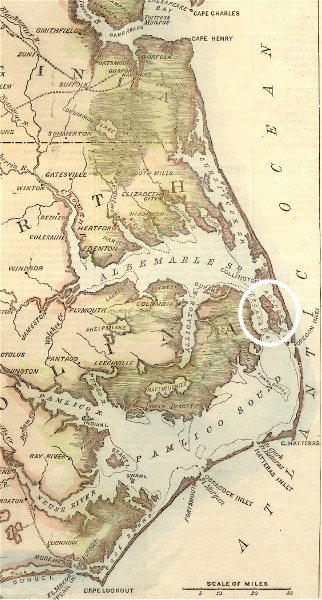
Map showing eastern North Carolina and the present day Outer Banks. Roanoke Island (circled in white) is located between the mainland (to its west) and the barrier islands (to its east).
The remaining six companies of the 3rd Georgia follow Colonel Wright south and wade ashore onto Roanoke Island September 1st. The entire regiment establishes Camp Rescue on the North end of the island. After conferring with the war department, Colonel Wright is given the go ahead to fortify the island.
Arriving on Roanoke Island at the same time as the Georgians is Engineer Charles H. Dimmock. He's been supervising the construction of Fort Oregon on the south side of Oregon Inlet. Company F of the 7th Regiment North Carolina State Troops and 150 indentured blacks arrive on the island soon after Dimmock does. The troops have been stationed at Fort Oregon along with the blacks who've been constructing it. After Hatteras fell the fort was blown up and it's cannon were brought to Roanoke Island.
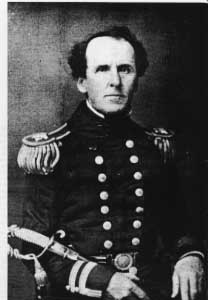
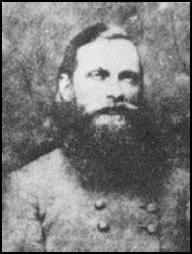
Captain William F. Lynch Colonel Ambrose R. Wright
Engineer Dimmock stakes out a site for a fort on Pork Point which juts out into Croatan Sound on Roanoke Islands west side. The shipping channel passes relatively close to land at the fort site and just within range of potential cannon fire. Thereare not enough tools for all of the men in the 3rd Georgia to work at one time so they build the fort in company shifts. Constructed in ten days and mounting seven guns it's called Fort Bartow. The Georgians then build Fort Huger at Weir's Point. It's the largest work on the island with twelve cannon. Several thousand feet south of Huger they construct four gun Fort Blanchard. The Georgians then throw up an eighty foot long earthwork astride the only north-south road on the island. Located at a place called Suple's Hill, this work is erected to guard Fort Bartow from its rear. A small two gun battery is erected on the east side shore line of the island. Roanoke Sound is considered too shallow for any threat from larger vessels.
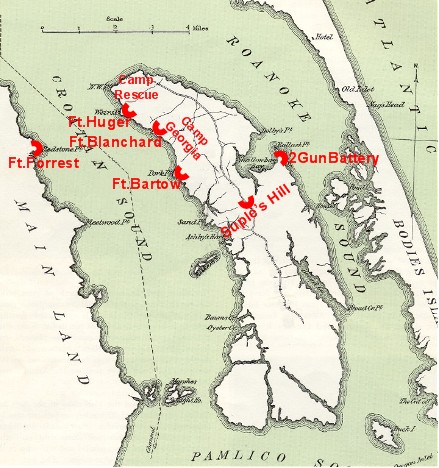
Map of Roanoke Island showing the locations of the forts constructed by the 3rd Georgia and their encampments.
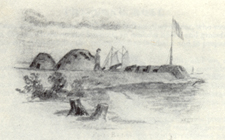
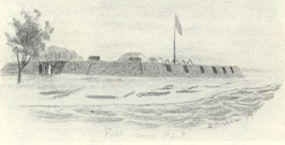
Drawings sketched by the 9th New York's Charles Johnson after the Union occupation of Roanoke Island. He drew Fort Bartow on the left and Fort Huger on the right.
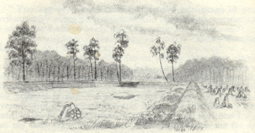
Fort Blanchard
After starting construction on the earthworks the Georgians move their encampment from the north end of the island to about halfway between the soon to be Forts Huger and Bartow, establishing Camp Georgia.
Two barges are rammed into the mud bank at Redstone Point on the mainland across the sound from Roanoke Island. Called Fort Forrest, this makeshift emplacement mounts four cannon.
On September21st,1861, the 8th North Carolina State Troops with Colonel Henry M. Shaw in command arrive on Roanoke Island. They encamp on the north end of the island, christening their new home Camp Raleigh.
The 8th North Carolina along with two companies of the 17th North Carolina and the 3rd Georgia, perform garrison duty in the newly constructed forts and earthwork.
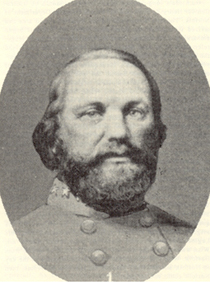
Colonel Henry M. Shaw, 8th Regiment North Carolina State Troops
Commodore Lynch commands a small flotilla of eight vessels which ply the sound waters surrounding Roanoke Island. Called "The Mosquito Fleet" because they can only "sting" an opponent, they are comprised of steam tugs mounting one or two cannon each. Several of the boats come in and out of Lynch's service during the fall of 1861 and early winter of 1862.